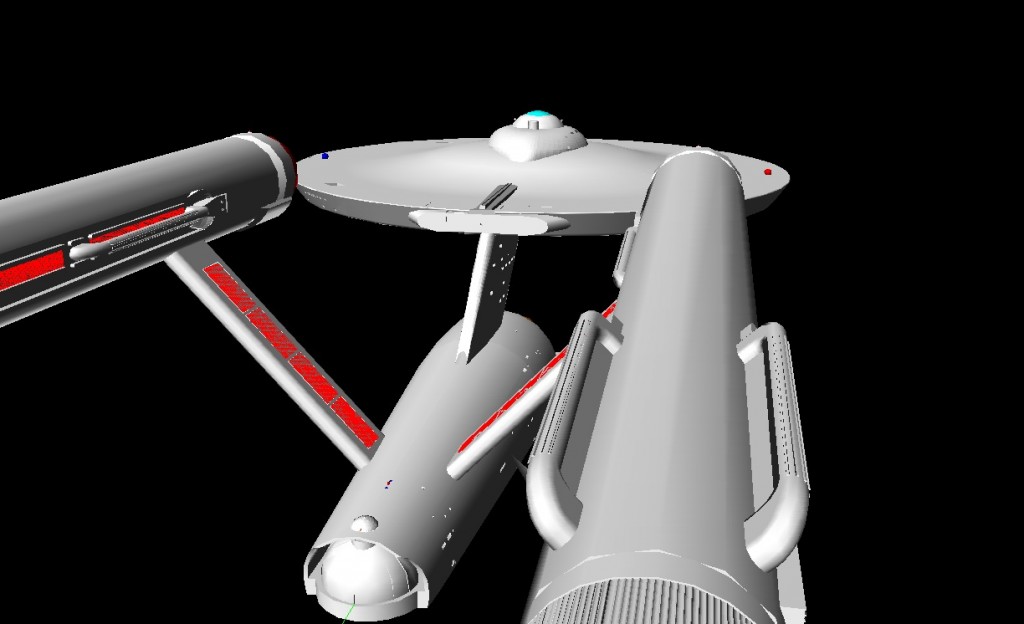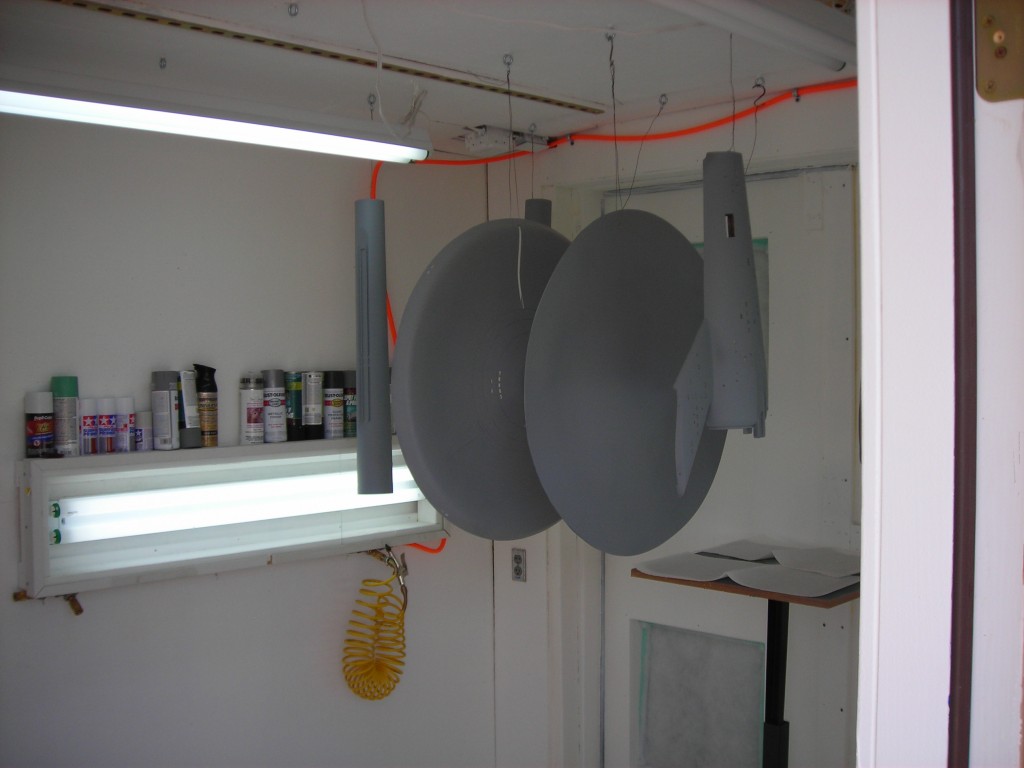Continued from the previous post.
After the plans are in order(I still tweak things as I go) , I see if things will work on the model by creating a 3d model out of my plans.
I did this years ago, whenever I make a 3d model I make it to work out the parts. I don’t bother with graphics and such at this stage. That stuff is easy when compared to the model itself.
I still can’t resist the beauty shots. When making a 3d model it allows me to do some really neat things in the real world.
WARNING: This is where things get interesting.
My first concern with taking on such a project is space.
Space to fabricate parts, space to paint the parts, and lastly space to display the model.
We needed some additional storage and getting tired of paying for a mini storage. Plus my Wife would like me to have a dedicated space to paint things(our last house got a bit messy because of my painting). So I designed and built a shed with a paint booth on the side.
It has an explosive proof fan with controls on the outside. Note the door position, it’s placed almost next to the the interior intake of the fan. So any dust or whatever will hopefully not make it’s way to anything I’m painting in there.
This is the control box, the meter is called a manometer. It tells me when I need to change the filters(besides looking at them). The switches are lights and the dial in upper left corner is the fan control.
These are the exterior intakes, I originally designed it as a set of doors. But that didn’t work so well(I turned them into a wall). I thought anything painted in there should be able to go through a door. Otherwise it’s never going to get in the house.
Here is the interior, it still needs to be painted. Note the ceiling it has hooks and rails for hanging parts. The fan is in the center of the image. The framing is for the filters, and there is 1/2″ screen to keep the filters in place.
Here is a shot of the interior. With my Little E(66″) being primered and you can see the hooks in use(the parts are drying in this pic).
The interior is painted white, with 4 sets of lights two fixtures on top and one on each side. The florescent orange hose is the air line, that’s used for airbrushes, paint guns, and for general clean-up(lol).
This view is toward the front. The filters are behind the paint arrestors(styrofoam grills) they help keep paint overspray out of the filters beyond.
They can get a bit messy.
Imagine the filter beyond if I didn’t have arrestors.
Since the booth relies on outside air, I have to watch the temperatures when painting.
That doesn’t bother me, in Arizona that’s just how things are.
I’ve got plenty to do indoors.
The next place that needed my attention was the garage or my shop(if you like).
Sadly I don’t have any pics of my shop during this time. But then I’m sure most of you can imagine a workspace such as mine, stuff and dust everywhere.
Cleaning it is a chore to be sure, except for the occasional find of treasure. I’m sure I’m not the only one that exclaims, “I didn’t know I had one of those!”.
That’s it for now.
Any questions, comments?











O M G !!! You are living the dream I have had for over 35 years. And I must say I have never seen it done this well. To say I am impressed, would not even scratch the surface. While I have been un-able to join, I have been following this on the RFP for the past few months, am I am very happy that you created this sight. I have been studying, drawing, sculpting, modeling and trying to re-create this ‘Supreme Icon of Science Fiction’ since I was 10 years old. Ever since the first time I bought an AMT model kit and discovered that there was almost nothing about it that was correct (of course that didn’t stop me from buying 10 more). A fire, that was further fueled by the obomination that was, the Franz Joseph Blueprints. For me, it seemed that every time someone tried to ‘bring back’ this great masterpiece of the imagination, they looked in all the wrong places for detail information and inspiration. The true beauty of this ship,
what she really looked like, Heavy, but sleek, graceful, but powerful, I feared would be lost forever. Keep putting it out there. Nothing else compares.
Thanks, JLM.
The AMT kit, oh boy. It does have a nostalgia factor, but I know what your saying.
Sadly the Franz Joseph stuff was all we had for years. I still have the tech manual, but I lost my constellation drawings ages ago.
That’s a lovely setup you’ve got there. I keep promising myself that I’ll sort out something similar but the other projects keep getting in the way.
I’ve still got my Franz Joseph frawings somewhere. I’ve often toyed with the idea of building a model based on them just to see what it’d look like in 3 dimensions but it’s not a priority.
Commander Max, if I may inquire; besides materials and construction techniques, is it your intention to build an absolutely accurate re-creation of the original 11 footer, or is the original only the basis for what you plan to build?
I explained it in part in my first post. No it’s not going to be an absolute replica. Not only would that be impossible, it would be very undesirable.
The only way to make an absolute replica is to replicate all of the flaws of the original.
It takes far far far more work to replicate somebody’s mistakes, than it would to make something straight and true. Besides I’m sure I’ll make my own mistakes.
It is obvious, that you do not plan to exactly duplicate the original model. But, I would assume that you do want these models to be as acurrate to the ‘intention’ of design, detail and dimensions of the original 11 foot model as possible. The real reason I asked the question, as if you probably couldn’t guess, was because I have noticed some things, that I can see, that are.. well…not quite right. Nothing serious. And most, the same issues that I see in everyone elses models, including, Greg Jein’s, the MR 66″, the 33s and the 1/350s. Some of the concerns I have, are with the reference or source materials. I see problems with line drawing on the ‘to boldly go’ page. I’m sure everyone wants to tell you how you should build these models, and I’m sure I’m just one more. But, as I mentioned before, I have been studying this model for 35 years. And while I don’t have rooms full of Enterprise models (anymore), or S.T. merchandise, I do have thousands of pictures, dozens and dozens of books and magazines and lots and lots of blueprints. Everytime I got new info, I went back to the drawing board. I never accepted anything without checking, cross-checking, crunching numbers on the calculater, comparing photos and making test models. I can say very confidently, that I have probably the most accurate, blueprints out there. But, they are all on velum, in 1/4th scale. You are the master builder, and I am impressed beyond imagination with this project. I am mearly the data bank that wants to help. I hope I haven’t affended you or annoyed you. But as far as I can tell, you are the only person building a model(s) of this caliber.
Respectfully,
John
It does offend me, because quite simply I don’t think you have understood my point. Perception is an individual thing, we all see different things. Trying to argue over the subject isn’t going to get me to change a thing. The design is complete, 99.999… of the guys that see this model in person will have no clue or care about high accuracy.
I’m sorry but unless you have miked up the original model, you can’t lay claim to truly accurate documents. I’ve learned this sort of thing from personal experience. You can’t do this stuff with photos alone.